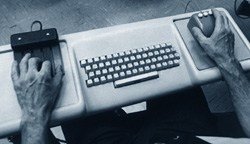| Question: | Considerng that getting new hardware on the market is very difficult, how about solutions such as holding down keys such as 'option' and 'command'? |
| Answer: | Those will be shortcuts which help speed up the operations in a clumsy limited way... |
| Notes: |
The chorded keyset is a five button device used in conjunction with the mouse and keyboard to quickly and efficiently input commands.  The five-key handset has 31 chords or unique key-stroke combinations, in five "cases." The first four cases contain lower and upper-case letters and punctuation, digits, and special characters. (The chords for the letters correspond to the binary numbers from 1 to 26.) The fifth case is "control case." A particular chord (the same chord in each case) will always transfer subsequent in put-chord interpretations to control case. In control case, one can "backspace" through recent input, specify underlining for subsequent input, transfer to another case, visit another case for one character or one word, etc. One-handed typing with the handset is slower than two-handed typing with the standard keyboard. However, when the user works with one hand on the handset and one on the mouse, the coordinated interspersion of control characters and short literal strings from one hand with mouse control actions from the other yields con siderable advantage in speed and smooth ness of operation. For literal strings longer than about ten characters, one tends to transfer from the handset to the normal key board. Both from general experience and from specific experiment, it seems that enough handset skill to make its use worthwhile can generally be achieved with about five hours of practice. Beyond this, skill grows with usage. From A Research Center for Augmenting Human Intellect (1968) |